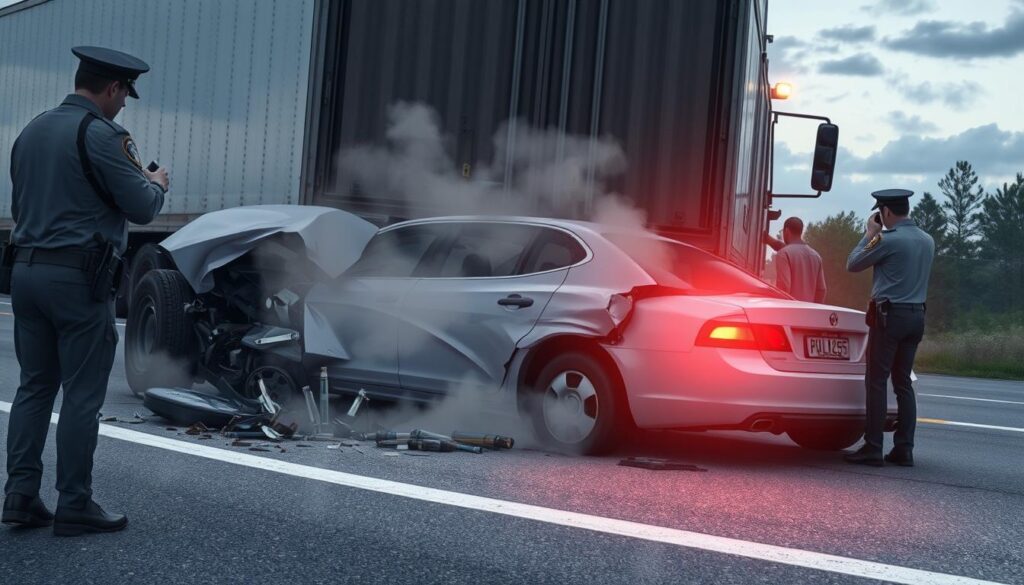What makes tailgating a truck a recipe for disaster? The most dangerous type of vehicle to tailgate is often the one drivers ignore most—until it’s too late. In 2022, rear-end collisions caused 3,400 deaths, many involving large vehicles. Discover why staying back could save your life.
Key Takeaways
- Trucks need 2x longer stopping distance than cars.
- Rear-end crashes kill over 3,400 annually in the U.S.
- Tailgating big rigs increases injury risk by 70%.
- Truck blind spots hide 20x more space than regular cars.
- Modern safety tech can’t replace safe following distances.
Understanding Tailgating and Its Risks
Driving too close to another vehicle is called tailgating. This risky habit creates dangers of tailgating that can lead to severe crashes. Learning the basics helps drivers avoid life-threatening situations.
What is Tailgating?
It’s when you follow another car so closely that you can’t stop safely if they brake suddenly. Safe drivers leave a 3-4 second gap. Tailgating often involves:
- Staying within 2 seconds or less behind another vehicle
- Ignoring road conditions like rain or ice
- Not adjusting distance for larger vehicles
Statistics on Tailgating Accidents
“Rear-end collisions caused 17.3% of two-car crashes in 2023.” – National Safety Council
These crashes often result in whiplash, property damage, and sometimes fatal injuries. The data shows 1.7 million rear-end collisions occur yearly in the U.S., many linked to unsafe following distances.
Common Reasons for Tailgating
Drivers engage in this risky behavior for reasons like:
- Impatience during traffic delays
- Distracted driving (texting, eating)
- Aggressive driving styles
- Underestimating stopping distances
Even minor distractions can turn seconds of poor judgment into irreversible consequences. Awareness of these triggers is the first step to safer roads.
The Dangers of Tailgating Large Vehicles
Larger vehicles like trucks and buses aren’t just harder to pass—they hide deadly tailgating risks. Their size and weight change how drivers must react, and ignoring these facts can lead to disasters.
“Truck drivers often can’t see cars directly behind them, increasing the chances of collisions during sudden stops,” warns the National Highway Traffic Safety Administration (NHTSA).
Why Size Matters in Tailgating
Big vehicles block views and create massive blind zones. A semi-truck’s mirrors might miss a car tailgating, making it impossible for the driver to signal a lane change. If the truck swerves or stops abruptly, the car behind has no time to react. Blind spots and delayed reactions turn minor hazards into life-threatening tailgating risks.
The Impact of Weight on Stopping Distance
Weight adds braking challenges. A fully loaded 18-wheeler traveling at 65 mph needs up to 525 feet to stop—nearly twice a car’s distance. Tailgatingers caught in this zone face unavoidable crashes. Even a slight delay in their braking could mean a rear-end collision or getting crushed under the truck’s rear. Safety experts stress: tailgating risks rise exponentially with every ton of vehicle weight.
Stay 20-40 seconds back from large trucks. If you see their mirrors, they might not see you. Protect yourself by giving them space to maneuver safely.
5 Most Dangerous Vehicles to Tailgate
Staying too close to certain vehicles can turn routine drives into life-threatening scenarios. Understanding the consequences of tailgating these types of vehicles is key to avoiding collisions:
1. Pickup Trucks: A Silent Threat
- Underride guards fail in crashes, leaving smaller cars trapped under trailers
- Quick acceleration can catch drivers off guard during sudden stops
- Rear collisions cause 20% of pickup-related fatalities annually
2. Commercial Trucks: The Giants of the Road
- Stop distances exceed 200 feet—double that of passenger cars
- Blind spots extend up to 30 feet behind trailers
- 2023 data shows 68% of truck-related accidents involve following too closely
3. SUVs: High and Mighty Risks
- Higher ground clearance creates lethal crumple zones
- Rollovers occur at 3x the rate when tailgating SUVs
- Top-heavy design amplifies instability during sudden maneuvers
4. Buses: Bulk and Blind Spots
- Blind zones hide entire cars in rear views
- Emergency stops require 2x the distance of regular vehicles
- 2024 NHTSA reports link 45% of bus collisions to tailgating
How Different Vehicles Affect Safety
Vehicle design plays a critical role in road safety, especially when maintaining a safe following distance. Taller vehicles like SUVs or trucks can block views of traffic lights, potholes, or other hazards, forcing drivers behind to react faster. Understanding these differences helps avoid collisions.
Vehicle Height and Visibility
Large vehicles such as buses or delivery trucks sit higher but create blind spots for drivers behind. For instance, a pickup truck’s elevated bed might hide a stopped car ahead, leaving less time to brake. Always stay far enough to see the road ahead clearly.
Braking Capabilities of Various Vehicles
Stopping power varies by vehicle type. Trucks with heavy loads need longer to halt than smaller cars. Key factors include:
- Weight: Heavier vehicles require 2x or more stopping distance
- Brake System Quality: High-end cars often have advanced ABS tech
- Tire Traction: Off-road tires grip differently than passenger tires
A fully loaded semi-truck traveling 60 mph needs 300+ feet to stop—nearly double a car’s distance. Drivers must account for this when driving near big rigs.
Staying alert to these differences ensures safer roads. Adjust your safe following distance based on what’s ahead. Smaller cars might brake quickly, but a loaded van or SUV could react slower in emergencies.
Recognizing Tailgating Behavior
Spotting risky driving habits early helps prevent accidents. Knowing how to avoid rear-end collisions starts with recognizing when you or another driver are too close. Here’s what to watch for:
Signs You’re Too Close
- Can’t see the vehicle ahead’s mirrors or license plate.
- Aggressive drivers flashing lights or honking to signal you’re blocking them.
- No time to react if the car in front brakes suddenly.
How to Assess Your Following Distance
Use the three-second rule: pick a fixed object ahead, like a sign. When the car in front passes it, count seconds until your car reaches the same spot. If it’s less than three seconds, back off.
“A three-second following distance reduces crash severity by 30%.” – National Highway Traffic Safety Administration
In poor weather, double the time to six seconds. Staying alert to these cues keeps you and others safe. Small adjustments today can prevent big accidents tomorrow.
Legal Implications of Tailgating
Driving too close to others isn’t just dangerous—it’s illegal. Tailgating accidents often lead to serious legal consequences. Laws vary by state, but all prioritize road safety. Ignoring these rules can cost drivers their licenses, money, or even their freedom.

Traffic Laws in the U.S.
Many states classify tailgating as reckless driving. For example:
- California fines offenders up to $250 for unsafe following distances.
- Texas penal codes treat tailgating as a traffic offense, adding points to licenses.
- New York may suspend licenses after repeated violations.
Consequences of Tailgating Accidents
Cases involving tailgating accidents can result in:
- Fines: Up to $1,000 in some states.
- License penalties: Points leading to suspensions.
- Legal liability: Lawsuits for injuries or property damage.
“Negligent drivers face both criminal charges and civil lawsuits after causing preventable crashes.”
Insurance premiums skyrocket after collisions linked to tailgating. Courts often rule against drivers who violate following-distance rules. Prioritizing safety isn’t just ethical—it’s legally necessary.
Preventing Tailgating: Best Practices
Maintaining a safe distance is key to rear-end collision prevention. These steps help avoid risks and protect all road users.
Keeping Safe Distance
Follow these tips to stay safe on the road:
- Use the two-second rule: Watch the car ahead pass a landmark. Count to two—if you pass it faster, increase your following distance.
- Check brake lights: If you can’t see the vehicle ahead’s tires, you’re too close.
- In bad weather, double your following distance to account for longer stopping times.
Educating Drivers on Tailgating Risks
Education reduces accidents. Programs like NHTSA’s safe driving workshops teach drivers to recognize hazards. Employers should train fleet drivers on defensive driving. Even seasoned drivers benefit from refresher courses.
- Share real accident stories to highlight consequences.
- Use simulators for hands-on learning.
Small adjustments in habits and knowledge create big safety gains. Stay alert and share these tips with others to keep roads safer for everyone.
The Role of Driver Awareness
Maintaining focus behind the wheel is the first step in avoiding risks like tailgating. Defensive driving tips start with mindfulness—staying alert to surroundings and avoiding distractions. Even brief glances at phones or passengers can lead to split-second decisions with deadly consequences.
Mindfulness While Driving
- Scan mirrors every 5-8 seconds to track traffic patterns
- Keep hands on the wheel at 9 and 3 o’clock for quick control
- Plan escape routes—what if the car ahead slams brakes?
Recognizing Potential Hazards
Watch for clues signaling danger ahead:
- Brake lights flashing ahead: Slow early to avoid collision chains
- Blind spots of large trucks: Stay visible in mirrors or move ahead
- Road debris or potholes: Anticipate erratic driver reactions
“Driving is a shared responsibility. Stay alert to protect yourself and others.”
Defensive driving tips like these turn reactive driving into proactive safety. Awareness isn’t just about rules—it’s a mindset that saves lives.
Tips for Avoiding Tailgating
Staying safe on the road starts with smart choices when dealing with aggressive drivers or tight situations. These safety strategies help avoid collisions and reduce stress:
How to Handle Aggressive Drivers
- Avoid sudden stops. Ease off the brake to warn tailgaters—tap brakes gently or flash headlights.
- Move to the right. Let faster vehicles pass if they’re pressing closely.
- Pull over if needed. Safely exit the road to calm an aggressive driver.
“Maintain focus on your driving. Never engage in confrontations,” advise highway safety experts.
When to Change Lanes Safely
- Check mirrors and blind spots twice before moving.
- Signal early to give others time to react.
- Only shift lanes when traffic ahead is clear and speeds are manageable.
Never force a lane change in heavy traffic. Wait for gaps large enough to merge without rushing.
Vehicle Features That Enhance Safety
Modern cars come packed with tech designed to keep roads safer. Features like ADAS and rearview cameras give drivers tools to avoid dangerous situations, like tailgating big trucks.
Advanced Driver-Assistance Systems (ADAS)
ADAS uses sensors and cameras to warn drivers of risks. Systems like automatic emergency braking and adaptive cruise control help maintain safe distances. For example:
- Rear collision alerts warn if a crash is likely
- Blind-spot monitoring spots trucks in adjacent lanes
- Speed sign recognition adjusts cruise control to match limits
The Importance of Rearview Cameras
A 2023 NHTSA report found rearview cameras reduce backing collisions by 15%. These systems provide clear views behind the vehicle, crucial when following large trucks.
“Cameras cut blind zones by 90% in reverse, but their front-facing cousins also improve visibility during following distance checks,” says the Insurance Institute for Highway Safety.
Combining these features with mindful driving creates a shield against accidents. Always check if your vehicle has these tools—and use them wisely.
Sharing the Road with Different Vehicle Types
Driving safely means knowing how to handle diverse vehicles on the road. Large trucks and buses require extra caution due to their size and stopping distances. Smaller cars must also take steps to stay visible and avoid risky moves. Follow these tips to reduce collision risks and improve roadway harmony.
“Maintaining a 4-second following distance cuts accident risks by 30%.” – National Highway Traffic Safety Administration
When near big trucks or buses:
Guidelines for Interacting with Large Vehicles
- Stay out of blind spots. Trucks have limited visibility directly behind and to the sides.
- Leave 20+ car lengths when passing. Sudden lane changes near large vehicles can cause rollovers.
- Signal turns early. Give truck drivers time to adjust their paths.
For drivers of smaller cars:
Tips for Motorists in Smaller Cars
- Keep 4-seconds distance. Use this rule behind trucks: count “one thousand one, one thousand two” after passing an object.
- Avoid cutting off. Large vehicles need double the stopping distance of cars.
- Use headlights at dawn/dusk. Increased visibility helps truckers spot smaller vehicles.
Safe sharing starts with awareness. Respect size differences and follow these steps to protect yourself and others on the road.
Conclusion: Drive Safe and Stay Aware
Staying safe on the road starts with respecting the space around every vehicle. Tailgating large trucks, SUVs, or buses puts lives at risk, as highlighted by recent accident reports showing over 25% of rear-end collisions involve these vehicles. Small actions like keeping distance and using modern safety tech can prevent tragedies.
Summarizing Tailgating Dangers
Rushing too close to big trucks or commercial vehicles leaves no room to react if they brake suddenly. Heavy vehicles take longer to stop, and their blind spots hide smaller cars. Data from the NHTSA shows 1 in 5 tailgating accidents involve trucks, often leading to rollovers or jackknifing. Ignoring these risks can mean costly repairs, injuries, or legal penalties.
Encouraging Responsible Driving Practices
Protect yourself by always leaving a 4-second gap in good conditions. Use features like automatic emergency braking or rearview cameras to stay alert. Follow traffic laws—many states ticket tailgaters with fines up to $500. Share the road responsibly: slow down when passing trucks, signal early, and avoid distractions. Defensive driving means staying focused and anticipating other drivers’ moves.



















